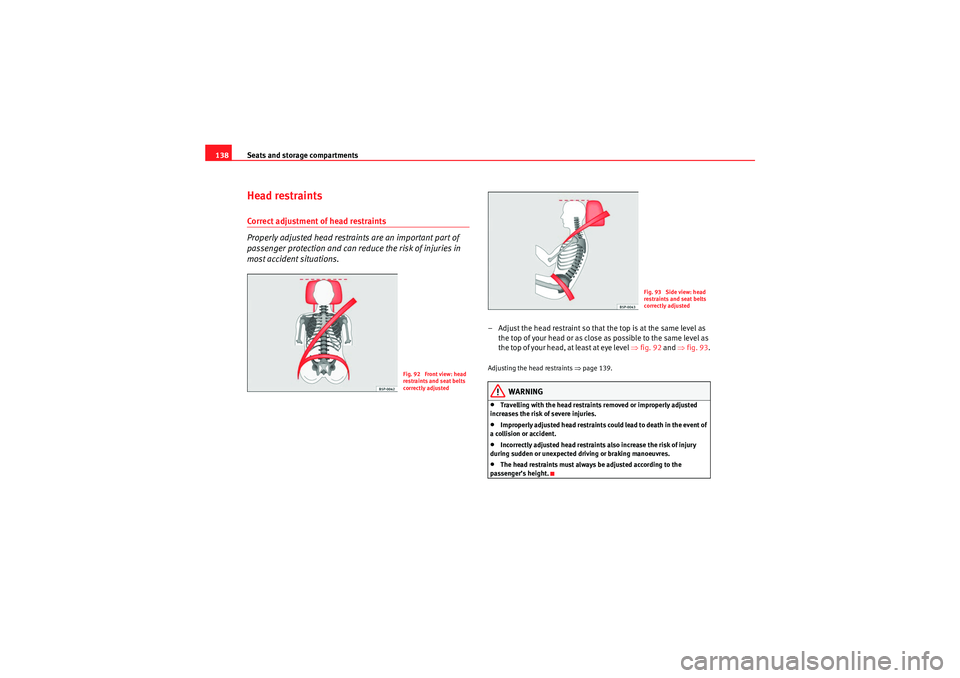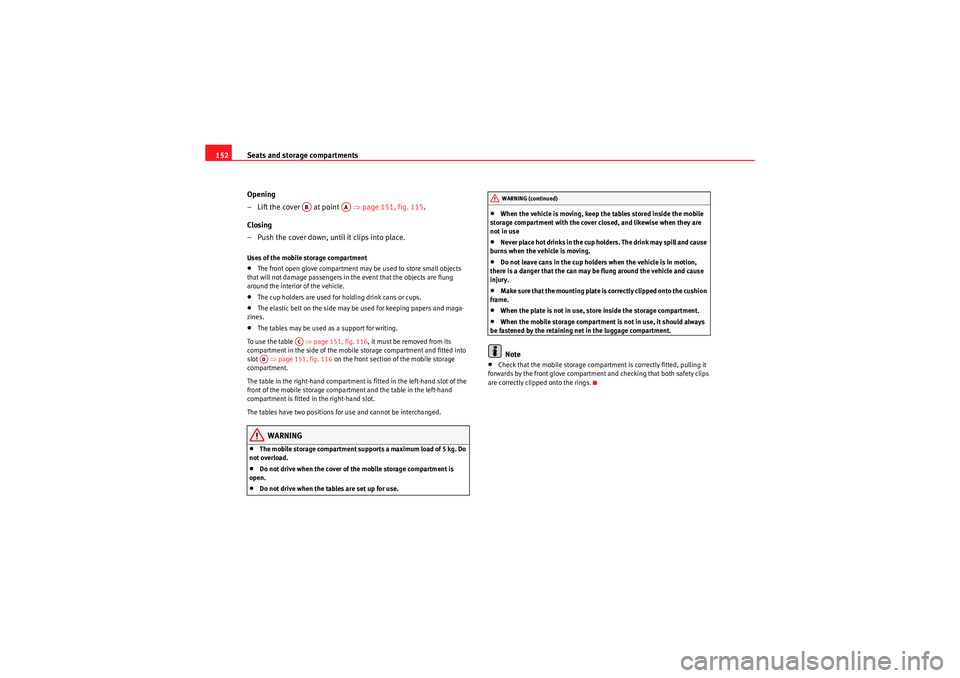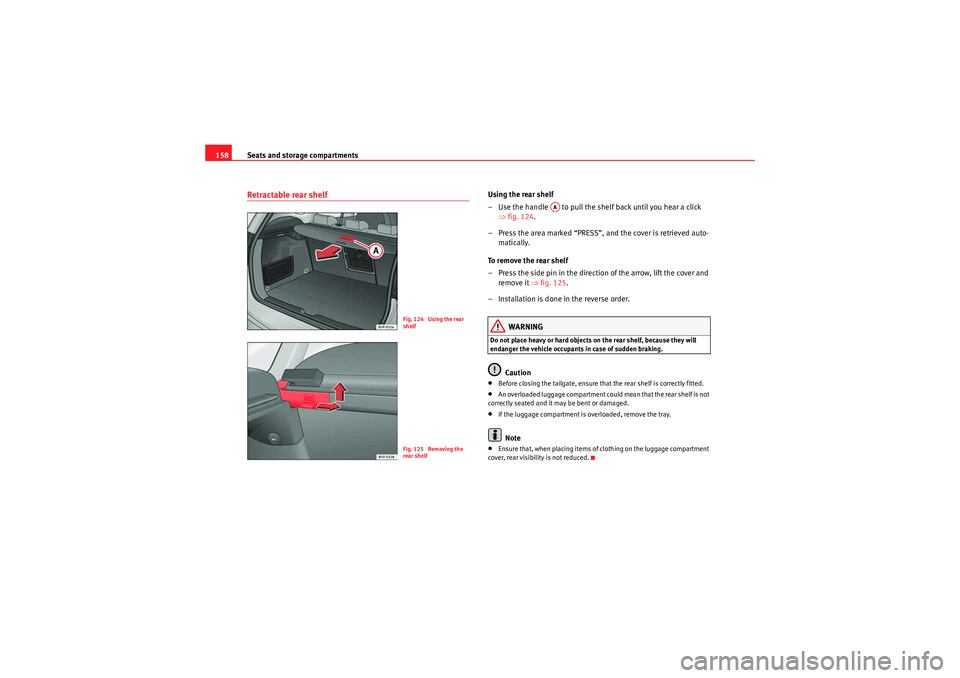2011 Seat Altea XL remove seats
[x] Cancel search: remove seatsPage 15 of 319

Safe driving13
Safety First
Operating Instructions
Practical Tips
Technical Specifications
Correct adjustment of front seat head restraints
Properly adjusted head restraints are an important part of
passenger protection and can reduce the risk of injuries in
most accident situations.
Adjust the head restraint properly in order to achieve maximum
protection.
– Adjust the head restraint so that its upper edge is at the same
level as the top of your head or as close as possible to the same
level as the top of your head and, at the very least, at eye level
⇒fig. 3 and ⇒fig. 4 .Adjusting the head restraints ⇒page 137.
WARNING
•Travelling with the head restraints removed or improperly adjusted
increases the risk of severe injuries.•Incorrectly adjusted head restraints could result in death in the event of
a collision or accident.•Incorrectly adjusted head restraints also increase the risk of injury
during sudden or unexpected driving or braking manoeuvres.•The head restraints must always be adjusted according to the
passenger’s height.
Active head restraints*Vehicle occupants are pressed into their seats during a rear end collision. The
resulting body pressure on the backrest activates the active head restraint*
on the front seat, which moves rapidly forwards and upwards at the same
time. This movement reduces the distan ce between the occupant’s head and
the head restraint, thus reducing the risk of head injuries such as brain
trauma.
Fig. 3 Properly adjusted
head restraint viewed
from the frontFig. 4 Properly adjusted
head restraint viewed
from the side
AlteaXL_EN.book Seite 13 Donnerstag, 9. September 2010 12:13 12
Page 31 of 319

Seat belts29
Safety First
Operating Instructions
Practical Tips
Technical Specifications
Service and disposal of belt tensionersThe belt tensioners are components of the seat belts that are installed in the
seats of your vehicle. If you work on the belt tensioners or remove and install
parts of the system when performing other repair work, the seat belt may be
damaged. The consequence may be that, in the event of an accident, the belt
tensioners function incorrectly or not at all.
So that the effectiveness of the seat belt tensioner is not reduced and that
removed parts do not cause any injuries or environmental pollution, regula-
tions, which are known to the specialised workshops, must be observed.
WARNING
•Improper use or repairs not carried out by qualified mechanics increase
the risk of severe or fatal injuries. The belt tensioners may fail to trigger or
may trigger in the wrong circumstances.•Never attempt to repair, adjust, remove or install parts of the belt
tensioners or seat belts.•The seat belt tensioner, seat belt and automatic retractor cannot be
repaired.•Any work on the belt tensioners and seat belts, including the removal
and refitting of system parts in conjunction with other repair work, must be
performed by a specialised workshop only.•The belt tensioners will only provide protection for one accident and
must be changed if they have been activated.
AlteaXL_EN.book Seite 29 Donnerstag, 9. September 2010 12:13 12
Page 40 of 319

Airbag system
38hold the passengers on the front seats and the outer rear seats in a position
where the side airbags can provide maximum protection.
The airbag system is not a substitute for seat belts, but it is an integral part
of the vehicle’s overall passive safety system. Please bear in mind that the
airbag system can only work effectively when the occupants are wearing their
seat belts. Therefore, it is most important to wear the seat belts at all times,
not only because this is required by law in most countries, but also for your
safety ⇒page 19, “Brief introduction”.
The side airbag system will not be triggered if:•the ignition is switched off•there is a minor side collision•there is a frontal collision•there is a rear-end collision•the vehicle turns over
The main parts of the airbag system are:•an electronic control and monitoring system (control unit)•The front side airbags in the backrests of the front seats and the rear side
airbags in the lining of the rear wheel housing•a warning lamp
�T on the instrument panel ⇒page 31
The airbag system operation is monitored electronically. The airbag warning
lamp will light up for approx. 4seconds ever y time the ignition is switched on
(self-diagnosis).
WARNING
•In a side-on collision the side airbags will not work if the sensors do not
correctly measure the pressure increase on the interior of the doors, due to
air escaping through the areas with holes or openings in the door panel.•Never drive the vehicle if the interior panels have been removed.
•Never drive if the interior door panels have been removed or if the
panels have not been correctly fitted.•Never drive the vehicle if the loudspeakers in the door panels have
been removed, unless the holes left by the loudspeakers have been
correctly closed.•Always check that the openings are closed or covered if loudspeakers
or other equipment are fitted in the interior door panels.•Any work carried out to the doors should be made in a specialised work-
shop.•The seat belts and airbags can only provide maximum protection if the
occupants are seated correctly ⇒page 10, “Proper sitting position for
occupants”.•If a fault has occurred in the airbag system, have the system checked
immediately by a specialised workshop. Otherwise, during a side collision,
the system may fail to trigger, or not trigger correctly.WARNING (continued)
AlteaXL_EN.book Seite 38 Donnerstag, 9. September 2010 12:13 12
Page 140 of 319

Seats and storage compartments
138Head restraintsCorrect adjustment of head restraints
Properly adjusted head restraints are an important part of
passenger protection and can reduce the risk of injuries in
most accident situations.
– Adjust the head restraint so that the top is at the same level as
the top of your head or as close as possible to the same level as
the top of your head, at least at eye level ⇒ fig. 92 and ⇒fig. 93 .Adjusting the head restraints ⇒page 139.
WARNING
•Travelling with the head restraints removed or improperly adjusted
increases the risk of severe injuries.•Improperly adjusted head restraints could lead to death in the event of
a collision or accident.•Incorrectly adjusted head restraints also increase the risk of injury
during sudden or unexpected driving or braking manoeuvres.•The head restraints must always be adjusted according to the
passenger’s height.
Fig. 92 Front view: head
restraints and seat belts
correctly adjusted
Fig. 93 Side view: head
restraints and seat belts
correctly adjusted
AlteaXL_EN.book Seite 138 Donnerstag, 9. September 2010 12:13 12
Page 141 of 319

Seats and storage compartments139
Safety First
Operating Instructions
Practical Tips
Technical Specifications
Removing or adjusting head restraints
The head restraints can be adjusted by moving them up and
down.Adjusting height (front seats)
– Press the button on the side and pull upwards to the desired
position.
– To lower the head restraint, press the button and push head
restraint downwards.
– Make sure that it engages securely into position.
Adjusting height (rear seats)
– Press the button on the side and pull upwards to the desired position. – To lower the head restraint,
press the button and push head
restraint downwards.
– Make sure that the head restraint engages securely in one of its positions ⇒page 14.
Angle adjustment (front seats)
– Press the head restraint forward or back to the required position.
Removing the head restraint
– Push the head restraint up as far as it will go.
– Press the button ⇒fig. 94 (arrow).
– Pull head restraint out of fitting without releasing the button.
Fitting the head restraint
– Insert the head restraint into the guides on the backrest.
– Push head restraint down.
– Adjust the head restraint to suit body size ⇒page 14 and
⇒ page 13.
WARNING
•Never drive if the head restraints have been removed. Risk of injury.•Never drive if the head restraints are in an unsuitable position, there is
a risk of serious injury.•After refitting the head restraint, you must always adjust it properly for
height to achieve optimal protection.•Please observe the safety warnings in ⇒page 138, “Correct adjust-
ment of head restraints”.
Fig. 94 Adjusting and
removing the head
restraints
AlteaXL_EN.book Seite 139 Donnerstag, 9. September 2010 12:13 12
Page 153 of 319

Seats and storage compartments151
Safety First
Operating Instructions
Practical Tips
Technical Specifications
– Place the mobile storage compartment onto the foam of the
central seat.
– Set both mounting pieces together ⇒page 150, fig. 113 ,
with both mounting rings ⇒page 150, fig. 114 and press
hard until both the clips completely connect with the rings.
Removing mobile storage compartment
– Pull each of the buttons ⇒ page 150, fig. 113 on the clips
(red buttons) forwards, until they snap out of place.
– Fold the larger seat down and remove the mobile storage compartment mounting plate.
Multi-purpose mobile storage compartment* - General information
This storage compartment may only be placed in the central
area of the rear seat
AE
AG
AF
Fig. 115 Mobile storage
compartment. OpeningFig. 116 Mobile storage
compartment. Functions
AlteaXL_EN.book Seite 151 Donnerstag, 9. September 2010 12:13 12
Page 154 of 319

Seats and storage compartments
152
Opening
– Lift the cover at point ⇒page 151, fig. 115 .
Closing
– Push the cover down, until it clips into place.Uses of the mobile storage compartment•The front open glove compartment may be used to store small objects
that will not damage passengers in the event that the objects are flung
around the interior of the vehicle.•The cup holders are used for holding drink cans or cups.•The elastic belt on the side may be used for keeping papers and maga-
zines.•The tables may be used as a support for writing.
To use the table ⇒page 151, fig. 116 , it must be removed from its
compartment in the side of the mobile storage compartment and fitted into
slot ⇒page 151, fig. 116 on the front section of the mobile storage
compartment.
The table in the right-hand compartment is fitted in the left-hand slot of the
front of the mobile storage compartment and the table in the left-hand
compartment is fitted in the right-hand slot.
The tables have two positions for use and cannot be interchanged.WARNING
•The mobile storage compartment supports a maximum load of 5 kg. Do
not overload.•Do not drive when the cover of the mobile storage compartment is
open.•Do not drive when the tables are set up for use.
•When the vehicle is moving, keep the tables stored inside the mobile
storage compartment with the cover closed, and likewise when they are
not in use•Never place hot drinks in the cup holders. The drink may spill and cause
burns when the vehicle is moving.•Do not leave cans in the cup holders when the vehicle is in motion,
there is a danger that the can may be flung around the vehicle and cause
injury.•Make sure that the mounting plate is correctly clipped onto the cushion
frame.•When the plate is not in use, store inside the storage compartment.•When the mobile storage compartment is not in use, it should always
be fastened by the retaining net in the luggage compartment.Note
•Check that the mobile storage compartment is correctly fitted, pulling it
forwards by the front glove compartment and checking that both safety clips
are correctly clipped onto the rings.
AB
AA
AC
AD
WARNING (continued)
AlteaXL_EN.book Seite 152 Donnerstag, 9. September 2010 12:13 12
Page 160 of 319

Seats and storage compartments
158Retractable rear shelf
Using the rear shelf
– Use the handle to pull the shelf back until you hear a click
⇒fig. 124 .
– Press the area marked “PRESS”, and the cover is retrieved auto- matically.
To remove the rear shelf
– Press the side pin in the direction of the arrow, lift the cover and remove it ⇒fig. 125 .
– Installation is done in the reverse order.
WARNING
Do not place heavy or hard objects on the rear shelf, because they will
endanger the vehicle occupants in case of sudden braking.
Caution
•Before closing the tailgate, ensure that the rear shelf is correctly fitted.•An overloaded luggage compartment could mean that the rear shelf is not
correctly seated and it may be bent or damaged.•If the luggage compartment is overloaded, remove the tray.Note
•Ensure that, when placing items of clothing on the luggage compartment
cover, rear visibility is not reduced.
Fig. 124 Using the rear
shelfFig. 125 Removing the
rear shelf
AA
AlteaXL_EN.book Seite 158 Donnerstag, 9. September 2010 12:13 12